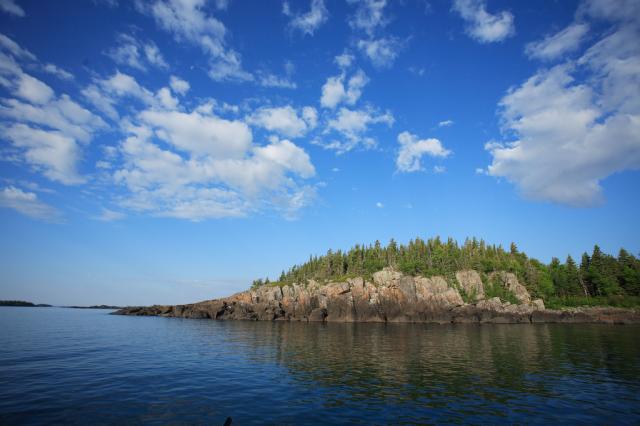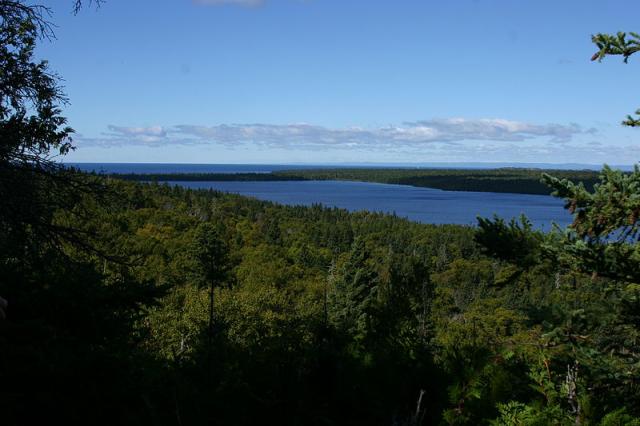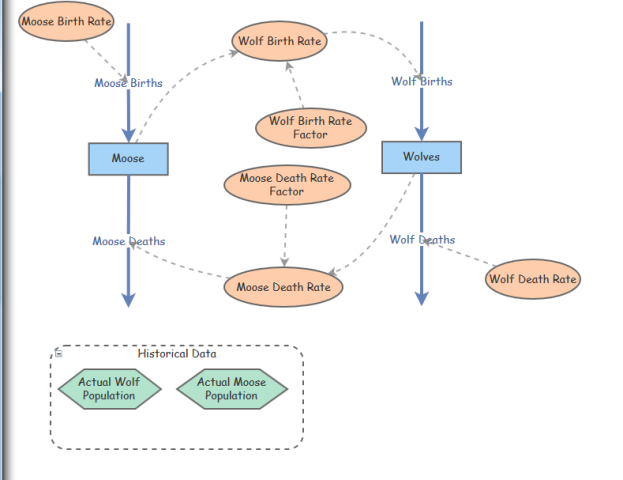
Isle Royale is an archipelago of islands located on Lake Superior just twelve miles from the Canadian shore. In the early 1900s a population of moose swam to Isle Royale . In the mid 1900s, a pair of wolves crossed over ice to the island.
In 1958, researchers began to observe and record the wolf and moose populations on Isle Royale. In this learning object, you will be asked to 1) record your expectations on what happened to the moose on Isle Royale when wolves were introduced, 2) to view and draw conclusions from a highly simplistic model that illustrates the predator-prey interactions on the island and 3) to compare and contrast the model with the actual observations on the island and the number of wolves and moose recorded each year.
The primary objective of this learning object is to observe how the population of one species can impact another and describe that interaction from a systems point of view . This is the predator-prey feedback loop. We see it in action on Isle Royal, which allows us to observe the interaction of two species in a way that is extraordinarily unique.
Let's start with some background information and then we will ask what you anticipate would happen when a pair of wolves are introduced to an island inhabited by moose.
image credit: Isle Royale, Lake Superior. (Ray Dumas via Creative Commons 2.0)
Copyright 2016 John A. Vucetich All Rights Reserved.

Isle Royale is a remote wilderness island, isolated by the frigid waters of Lake Superior, and home to populations of wolves and moose. As predator and prey, their lives and deaths are linked in a drama that is timeless and historic. Their lives are historic because we have been documenting their lives for more than five decades. This research project is the longest continuous study of any predator-prey system in the world.
The purposes of this project are to better understand the ecology of predation and what that knowledge can teach us about our relationship with nature. Much of what we have learned is associated with having been patient enough to observe and study the fluctuations in wolf and moose abundances summarized above.
Isle Royale has offered many discoveries… how wolves affect populations of their prey, how population health is affected by inbreeding and genetics, what moose teeth can tell us about long-term trends in air pollution, how ravens give wolves a reason to live in packs, why wolves don’t always eat all the food that they kill, and more. The wolves and moose of Isle Royale also frequently reveal intimate details of their daily life experiences and they have inspired numerous artistic expressions. If we pay attention, they all tell us something important about our relationship with nature. These insights and discoveries are all presented here for you.

Isle Royale is an archipelago of islands located on Lake Superior just twelve miles from the Canadian shore. In the early 1900s a population of moose swam to Isle Royale . In the mid 1900s, a pair of wolves crossed over ice to the island.
In 1958, researchers began to observe and record the wolf and moose populations on Isle Royale. In this learning object, you will be asked to 1) record your expectations on what happened to the moose on Isle Royale when wolves were introduced, 2) to view and draw conclusions from a highly simplistic model that illustrates the predator-prey interactions on the island and 3) to compare and contrast the model with the actual observations on the island and the number of wolves and moose recorded each year.
The primary objective of this learning object is to observe how the population of one species can impact another and describe that interaction from a systems point of view . This is the predator-prey feedback loop. We see it in action on Isle Royal, which allows us to observe the interaction of two species in a way that is extraordinarily unique.
Let's start with some background information and then we will ask what you anticipate would happen when a pair of wolves are introduced to an island inhabited by moose.
image credit: Isle Royale, Lake Superior. (Ray Dumas via Creative Commons 2.0)
Describe the ensuing impact on both wolf and moose populations in the years after 1948. Your answer will not be judged right or wrong. It simply reflects what you expect before looking at the model and the actual data.

The link below loads an interactive model that illustrates predator prey interactions using real-life data of wolf and moose populations on the Isle Royale.
Experiment with adjusting the initial number of moose and wolves on the island. Click on the Simulate button. Draw conclusions about the relationship of the number of wolves and moose. What happens to the population when wolf and moose populations are increased and decreased?
Click for Isle Royal Simulation
Select all of the true statements about the accuracy of the model in relationship to actual moose and wolf populations on Isle Royale?
A spike in the moose population is generally followed by a ____________ in the wolf population.
After viewing the simulation and changing the initial moose and wolve populations, what have you concluded?
After a student has tried the simulation and then summarized his or her conclusion, the learning object could then unlock the expert's explanation of the phenomenon on Isle Royale. This page for example could be conditionally unlocked.
Alternatively, the instructor might have students discuss their findings in a discussion forum. Subsequently, the learning management system could be set up with a release condition to unlock the instructor's or expert's point of view. In other words, students must complete the learning object and participate in the discussion before being offered the expert's interpretation. The amount of engagement with the content would be significant before students are given an explanation of the phenomenon.
For further study and for an interesting look at the actual data, please visit the project site:
http://www.isleroyalewolf.org/overview/overview/at_a_glance.html